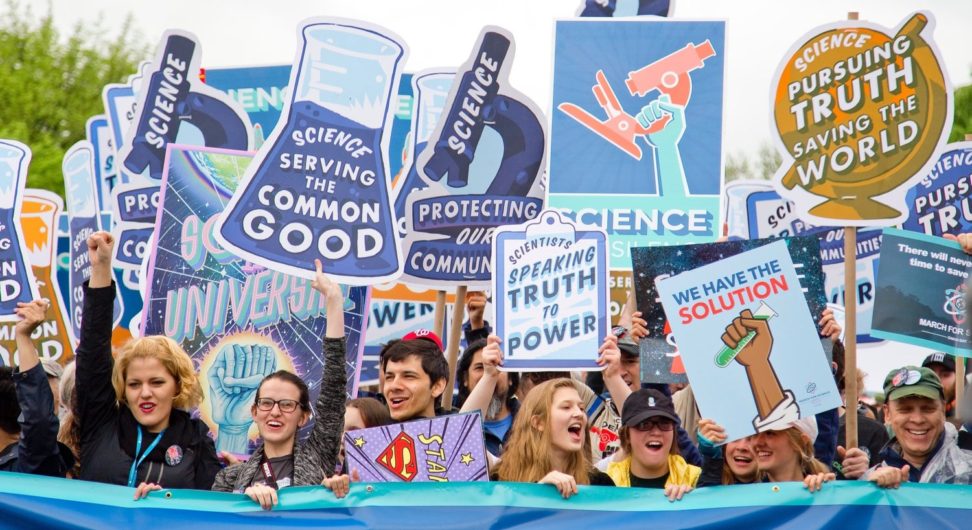Scientists & Storytellers Unite! 10 Steps to Cultivating a Beautiful Relationship
This piece originally appeared on Studio Mobius. It is re-posted here with permission.
“Before they’ll listen to you, they have to like you.”
This wise statement came from a co-worker with a PhD, a woman who built her reputation on the thoroughness and accuracy of her methods, analysis, and recommendations.
And yet, there she was, acknowledging that proof points alone would matter not a lick if we couldn’t find a way to connect with people. I wanted to fist bump her across the conference table.
For communicators, experts are among our most important collaborators. Brand claims must be defensible, grounded in truth: This is the place from which stories find their power.
Building a strong relationship with experts means you have a powerhouse of story potential.
Unfortunately, I’ve heard marketers and branders disparage scientists and program experts — because they “ruin copy” or “just don’t get it.” (Similarly, many experts steer clear of marketers because they play fast and loose with the facts.)
As a journalist, I’ve never understood this pugilistic standoff. Building a strong relationship with experts means you have a powerhouse of story potential. Sure, your expert may initially wonder why you’re not just plopping bullet points in front of their impressive roster of evidence and sending it out into the world.
It’s the communicator’s role to help them see the importance of narrative and — gasp, feelings — in getting real live humans to connect with their research.
Here are 10 ways to build a positive partnership.
1. Value expertise. Full stop. Respect and recognize the awesomeness of your big-thinking experts.
2. Stay curious. Scientists may want to to tell you… all the things. They can be as enamored with the details of processes as with the results. Get in there with them. Ask all your curious questions. Show them you care — by caring about their work.
At some point, ask your expert this: “How do you want people to feel about your work?” The room may go so quiet you can hear yourself blink, but impactful stories aren’t created from analytical message-mapping, Post-It note sessions, and dot exercises alone.
3. Ask them to tell you a story. It’s important to move from what the research is to why it matters. Get out of the theoretical and into the positive impacts. Ask them to tell you about how their work will change the lives of people. What’s the potential real-world benefit to just one person? Why should people actually care?
4. Pivot the conversation from information to emotion. If you eat a big ol’ pile of kale, a tablespoon of olive oil helps the body absorb good nutrients. Similarly, emotions prime people to retain nutritive facts. So, at some point, ask your expert this: “How do you want people to feel about your work?” The room may go so quiet you can hear yourself blink, but impactful stories aren’t created from analytical message-mapping, Post-It note sessions, and dot exercises alone. Do we want people to feel proud? Outraged enough to act?
5. Get Venn. Drawing a simple Venn diagram can help you find common ground. On one circle list the most important true statements about the research/data/science. This is Our Truth (call it whatever you like). On the other circle, list things you know about the audience you’re trying to reach — what they need to hear, feel, do. These are your Audience Needs.
6. Find your common ground. You’ll likely see some connection points between Our Truth and Audience Needs, places where the data can deliver what people want. Those are the parts of the story you want to focus on — the things that will make your audience sit up and listen.
7. Make a proposal. At this point, you should have enough to work out a couple of possible ideas or messages for your expert to respond to. Ask them what they think. Bring them along on the process.
8. Have a de-jargon party. Some people understand the need to jettison jargon. Others not so much. One idea? Read the phrases aloud and ask your expert whether your audience would understand the meaning. Then brainstorm other phrases together or volunteer to come up with a list on your own.
9. Write your story/sales deck/video script/press release, etc. Do the work. Read your piece out loud. How does it make you feel?
10. Stay open and grateful. This process is all about building a climate of trust, collaboration, and mutual respect. It may take a few projects before you’re in the total trust zone. That’s okay. Stay open to your expert’s point of view, go with their jargon when it’s important. Eventually, your “input time” will drop to almost nil because your expert knows they can trust you completely. And you have the creative freedom to drive your vision.
11. Win. Win.
This work is licensed under a Creative Commons Attribution-ShareAlike 4.0 International License.


